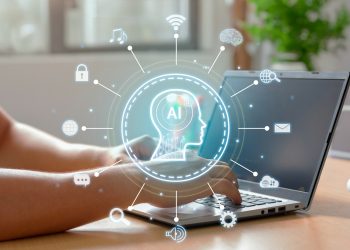Understanding AI Software Development
Importance of AI in Business
AI's making waves in business like never before. Its influence is spreading everywhere—healthcare, finance, marketing, retail, you name it. Why are folks so hyped? Because AI takes on repetitive tasks, letting people focus on the bigger picture things. Think of how it's spotting fraud at banks or predicting when machines might throw a tantrum in factories (fraud detection, anyone?).
More than just task automation, AI is ace at crunching numbers and spotting patterns. Its data analytics superpowers give businesses a leg-up on their decision-making skills. Suddenly, mysteries of customer behavior or market trends seem not so mysterious. Dive deeper into AI and data analytics to see what I mean.
And let's not forget the personal touch! AI chatbots and virtual assistants chat away with customers, offering instant help and tailored advice, winning over hearts and keeping people coming back for more.
| What AI Does in Business | Real-Life Cases |
|---|---|
| Automates Boring Stuff | Help Desks, Auditing Fun |
| Makes Better Calls | What's Gonna Sell, Spotting Risks |
| Keeps Folks Happy | Tailored Tips, Instant Gratification |
Key Components of AI Software Development
Building AI isn't magic (though it seems like it). It takes a mix of elements working in unison for AI systems to shine.
-
Data Collection and Prep: Think of data as the fuel for an AI engine. But it needs to be top-notch to avoid the AI model running on fumes. Prep involves scrubbing, tagging, and organizing data to kick bias and errors to the curb. Check out data preparation in AI for more.
-
Machine Learning Algorithms: The brains behind AI software. These algorithms help AI learn and get smarter over time. You’ve probably heard of decision trees or neural networks. They're central figures in this club. Learn more with our dive into neural networks in AI.
-
Natural Language Processing (NLP): Making sense of our words is key for apps like voice helpers and chat platforms. Get the scoop on how AI gets chatty with NLP developments.
-
Computer Vision: AI with eyesight? Yep, it interprets images like a pro, crucial for stuff like self-driving cars and surveillance tech.
-
Model Training and Testing: Feed that AI good info, let it find patterns, then test it to see if it knows its stuff. It's like AI school but cooler.
-
Continuous Monitoring and Improvement: AI’s gotta keep up with the times. Regular checkups ensure it handles fresh data with style.
| Important Parts | What They Do |
|---|---|
| Data Gathering | Getting data all neat and tidy |
| Machine Learning | Crafting the thinking cap |
| Language Skills | Messing with human lingo |
| Visual Proficiency | Understanding picture books |
| Training Routines | Learning and showing off |
| Keeping Up-to-Date | Staying sharp and current |
Nailing these components is a must if you want to make enchantment happen with AI in your biz. Get strategic, pick your tools wisely, and watch as you shift things into high gear with innovation. Curious for more? Peek into the realms of AI and smart cities and AI technology advancements.
Planning Your AI Software Project
Kicking off an AI project in your business needs some solid groundwork. We’ll dive into pinpointing what your business really needs and setting down some achievable aims and ambitions.
Identifying Your Business Needs
First things first, you need to know what's what in your business. Knowing what your business actually requires is the cornerstone of getting an AI project off the ground. This step is all about making your AI toolkit a perfect fit for tackling those quirky problems or grabbing those golden opportunities that make your business tick.
- Scoping Out Problems:
- Check out your current way of doing things to see any stumbling blocks.
- Figure out where AI can step in to do the boring tasks or offer some fresh insights.
- Spotting Possibilities:
- Look at how AI might open doors to new ways to make money.
- Keep your finger on the pulse of the market to see where AI might slide in smoothly.
- Making Friends with Stakeholders:
- Chat with folks in different parts of the business about what gets their goat.
- Make sure your AI plans fit in nicely with the big picture of the business’s direction.
Setting Clear Objectives and Goals
Now that you know what's needed, it's time to set clear targets so you don’t just end up running in circles. This bit is about setting goals you can actually measure, so everyone can tell the project’s paying off.
- Clear Targets:
- Work out exactly what you want out of your AI venture.
- Think about upping the ante on customer service, boosting sales, or making operations less of a slog.
- Measurable Goals:
- Use KPIs to keep tabs on how your AI project is shaping up.
- Think in numbers, like cutting down on the time it takes to get stuff done or seeing more smiles from your customers.
- Small Wins:
- Break everything into bite-sized chunks so the whole thing doesn't feel like you're scaling Everest.
- Set deadlines for each bit to keep the ball rolling and the wind in your sails.
| Objective | Example Goal | Metric |
|---|---|---|
| Better Customer Service | Halve the time it takes to respond to queries | Average response time |
| Pump Up Sales | Increase online sales by 20% | Monthly sales growth |
| Operational Streamlining | Slice processing time down by 40% | Time saved per task |
| Boost Data Crunching | Bump prediction accuracy by 30% | Prediction accuracy |
If you want more juicy details on where AI fits into the grand scheme, check out [artificial intelligence applications] or how it adds value to [business operations]. If a specific AI tech is on your agenda, nose around topics like [neural networks] or [natural language processing].
Getting your ducks in a row at the start by nailing down what your business needs and setting those sharp, measurable goals sets you up for AI success that really hits the nail on the head.
Selecting the Right AI Tools and Technologies
Picking the best AI tools and tech is like choosing the right partner in crime for your big software project—critical for hitting those success notes. Join me as we take a tour through three main arenas: machine learning, natural language wizardry, and computer vision’s eye for detail.
Machine Learning Algorithms
These algorithms are the brains behind most AI systems. They teach your software to get smarter over time, acting like a digital coach. Different algorithms have their own sweet spots like predicting outcomes, clustering stuff, or squeezing knowledge from chaos.
| Algorithm Type | Use Case | Example |
|---|---|---|
| Supervised Learning | Predicting Trends | ai for predictive analytics |
| Unsupervised Learning | Grouping Customers | machine learning in automation |
| Reinforcement Learning | Robot Training | ai in robotics |
| Neural Networks | Spotting Patterns | neural networks in ai |
The secret sauce is picking the right algorithm for what you’re tackling. Need to forecast customer moves? Supervised learning is your buddy.
Natural Language Processing
Natural Language Processing (NLP) is the go-to for apps needing to chat or understand human lingo. It empowers your AI with a Sherlock Holmes-like ability to dissect text and context, perfect for chatbots or figuring out emotions in customer reviews.
| NLP Application | Use Case | Example |
|---|---|---|
| Text Sorting | Spam Protection | natural language processing ai |
| Mood Reading | Customer Reviews | ai-powered virtual assistants |
| Entity Spotting | Info Digging | ai and data analytics |
| Translation | Language Bridging | ai and smart cities |
Want to jazz up how your biz chats with customers? Toss in some NLP magic like chatbots or emotion analyzers.
Computer Vision
Computer vision is all about machines seeing the world through visual data. Think of it as giving machines a pair of eyes. It's a boon for fields like healthcare and autos where seeing is believing.
| Computer Vision Application | Use Case | Example |
|---|---|---|
| Image Tagging | Diagnosing Ailments | ai in healthcare diagnostics |
| Object Spotting | Driving Autonomously | ai in self-driving cars |
| Face ID | Security Boost | ai for fraud detection |
| Video Insights | Shopping Intel | ai-powered video analytics |
Hooking up computer vision tech can do wonders for automating visual tasks—like ensuring products shine with quality in a factory.
Be smart about matching AI tools with what your biz actually needs, and you’ll shake up how things get done. Stay ahead by diving into more topics—like ai in marketing automation and ai for business automation.
Implementing AI Development Best Practices
Getting AI software development right isn't just about slapping some code together. It's about following solid practices that make sure your AI solutions work smoothly and meet your business needs.
Data Collection and Preparation
Data is the lifeblood of AI. Without good data, you're building on quicksand.
- Spot your data sources: Figure out where your data's coming from—whether it's your existing databases, web scouting, or outside sources.
- Clean up the mess: Ditch duplicates, fix mistakes, and deal with missing info. Your data's got to be spotless.
- Transform it: Make sure your data speaks the same 'language' by normalizing and standardizing it.
- Slice it up: Break your data into chunks for training, tweaking, and testing.
| Data Stage | Percentage of Data |
|---|---|
| Training Set | 70% |
| Validation Set | 15% |
| Test Set | 15% |
Dive deeper in our piece on AI and data analytics.
Model Training and Testing
Training and testing your AI models are like getting them ready for the big game.
- Pick the perfect model: Go for one that fits your needs—machine learning, deep learning, you name it.
- Train like you mean it: Use your training set to teach the model. Keep an eye on it and make the tweaks it needs.
- Fine-tuning: Your validation set is where you fine-tune things to avoid making rookie mistakes.
- Test it out: Put your model to the test with a test set to make sure it doesn't fall flat.
| Stage | Description |
|---|---|
| Model Training | Using training data to teach the model |
| Validation | Adjusting the model settings |
| Testing | Checking model accuracy and performance |
Check out neural networks in AI to get the full scoop.
Continuous Monitoring and Improvement
AI models aren't "set it and forget it." They need constant attention to stay sharp.
- Keep score: Watch how your AI models are doing using numbers like accuracy, precision, and recall.
- Feedback is gold: Set up a way to get real-time feedback to boost the model. This can be from user feedback or system data.
- Keep it fresh: Regularly give the model new data and retrain it so it stays in the game.
- Error check: Dive into errors to find where you're slipping.
| Performance Metrics | Description |
|---|---|
| Accuracy | Percentage of correct guesses |
| Precision | Ratio of true hits out of all hits |
| Recall | Share of real positives nailed |
| F1 Score | Balance between precision and recall |
Learn more about AI automation tools for better monitoring and upgrades processes.
Sticking to these best practices helps you unleash the true power of AI in your business, making sure your AI projects run efficiently and hit the mark with your goals.
Overcoming Bumps in AI Software Development
Keeping Data on the Down Low
When you're knee-deep in AI, keeping data private and secure is a must-do. You don't want any sneaky eyes on sensitive info, right? This means beefing up your defenses with solid encryption and locking down who can access what. Don't forget those regular check-ups to catch any fishy stuff lurking around.
| What You Need | Plan of Attack | Real-World Example |
|---|---|---|
| Encryption | Roll out that AES-256 goodness | Lock up data safe |
| Access Controls | Use role-based control (RBAC) | Keep users in their lane |
| Regular Audits | How about monthly check-ins? | Spot the shady spots |
For more on making your AI fortress solid, check out our piece on AI and Cybersecurity.
The Right Thing to Do
When it comes to AI, playing fair is the name of the game. Bias can make AI act all funky, treating people unfairly. So, fairness in your AI's code is key, and giving models a good twice-over for bias is your new best friend.
| Sticky Issue | How to Handle It | Suggested Read |
|---|---|---|
| Bias in Algorithms | Bias checks, mix it up with data | AI and Emotional IQ |
| Keeping it Honest | Use explainable AI tricks | AI's Neural Networks |
| Owning Up | Write it down, set policies | Thinking Ethically in AI |
Find out more on juicing up AI with ethics in our section on Artificial Intelligence Uses.
Revving Up Performance
When AI's slow, folks notice. Tweak things up: aim for the bulls-eye with model accuracy, speed things up, and use resources smartly. Try out hyperparameter tuning, trim the fat off models, and ramp it up with hardware boosts.
| Upgrade Needed | How to Upgrade | Action Plan |
|---|---|---|
| Model Precision | Tweak settings like a pro | Grid search, random search |
| Speeding Things Up | Power up with GPUs and TPUs | Faster processing |
| Smart Resource Usage | Prune models, reduce size | Easy deploy |
Get more tips on boosting AI tech in our article about AI for Business Boosts.
Quick Clicks
- AI and Cybersecurity
- Artificial Intelligence Uses
- AI's Neural Networks
- Thinking Ethically in AI
- AI for Business Boosts
Future Trends in AI Software Development
AI software development is like a wild ride, where staying ahead is crucial for anyone wanting to tap into the potential of artificial intelligence. Here’s a glimpse into a handful of trends that are sculpting the future of AI software.
Explainable AI
Explainable AI, or XAI if you're cool with acronyms, is all about unraveling the mystery behind AI's decision-making. As AI gets more intricate, understanding its choices becomes not just a fancy option but a necessity. Explainable AI promises to break down the ‘why’ and ‘how’ behind AI decisions, which is hugely important for building trust and keeping in line with all those pesky rules and regulations.
| Feature | Traditional AI | Explainable AI |
|---|---|---|
| Decision Transparency | Low | High |
| Regulatory Compliance | Tricky | You bet! |
| User Trust | Not much | Thumbs-up! |
Dig deeper into how this trend affects neural networks in AI.
Edge Computing
Edge computing takes the processing dance floor closer to where data is kicking up the dust, bypassing that massive cloud server up above. When it comes to AI applications, this means running models on handy gadgets like your smartphone or those nifty IoT devices. The result? A snappy performance with lower waiting times and less data gobbling.
| Metric | Cloud Computing | Edge Computing |
|---|---|---|
| Latency | Yawningly High | Swift as a breeze |
| Bandwidth Usage | Heavy Traffic | Easy Street |
| Scalability | Expandable | Let's Keep it Real |
Find out more about how edge computing meshes with AI in our article on edge computing and AI.
AI-driven Automation
AI-driven automation is turning business on its head by taking over dull, repetitive stuff and letting humans focus on the big picture. This not only cranks up efficiency but also frees folks to tackle strategic roles. AI-driven automation covers a spectrum of areas, from factories to hospitals, and is vital for supercharging those business gears.
| Area | Example Tasks | Benefits |
|---|---|---|
| Manufacturing | Upkeep predictions, quality checks | More uptime, lower expenses |
| Healthcare | Diagnoses guesstimates, checking on patients | Sharper accuracy, managed resources |
| Finance | Catching fraudsters, ticking off regulations | Better security, less risk |
Dive into the world of AI for business automation.
Peering into the future, AI software development is set to craft systems that are open, speedy, and handle stuff on their own, budding leaps across industries. For a broader look at AI’s toolbox across sectors, check out pieces on ai in healthcare diagnostics and ai for predictive maintenance.











